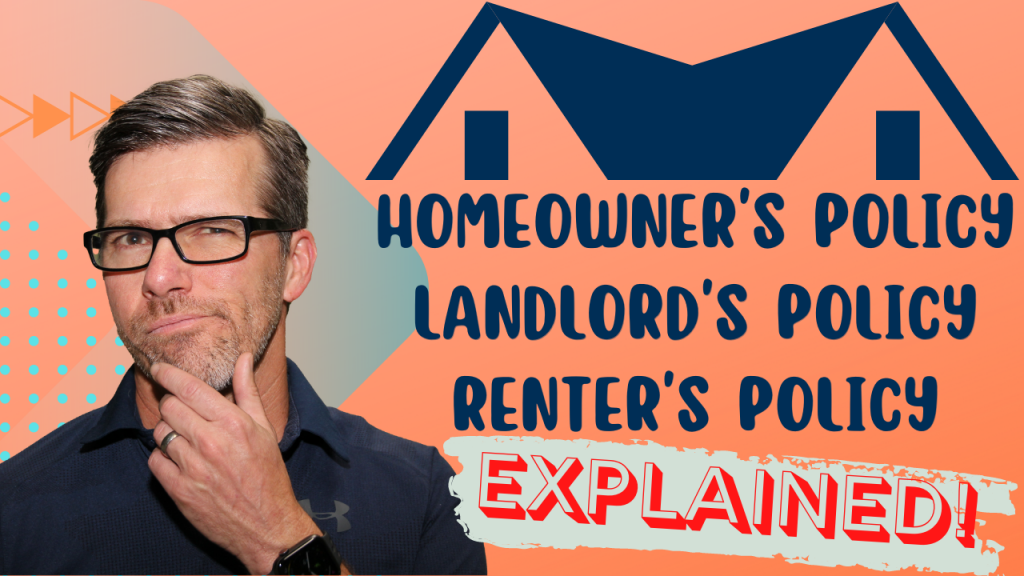There are 6 different types of policies you can get on your home. Make sure you have the right one.

Depending on if you own a home, have an apartment that you rent, or have purchased a condo, you will need one of six different policy types. If you have the wrong one, you may not have the coverage you need or not be covered at all.
In the insurance industry, we sometimes refer to these different policies as either HO3 or DP1, or HO6. Frankly, these probably don’t mean a thing to you, so I will try to help you understand.
The Six basic types are:
- HO-3, Homeowner
- H0-4, Renters
- H0-5, Homeowner (aka HO-3 + 15)
- HO-6, Condominium
- DP1 or DWG1 or Dwelling 1
- DP3 or DWG3 or Dwelling 3
Usually, we use either an HO-3 or HO-5 when insuring your home, and you own the entire structure or house. These two policies are very similar, with the H05 being an enhanced H03. We refer to both of these as a Homeowners Policy.

Both of these are policies with coverages packaged together with many coverage limits being automatically recommended based on the limit on the Dwelling. We talk more in-depth here: 6 primary coverages included in homeowners policy.
Understand that the primary difference between an HO3 and HO5 will be what things can happen to your personal property, and it still is covered by insurance. We call these “things that can happen” perils. We talk about that more here: Open vs. Named Perils.
The HO5 uses what we call “Open Perils” when describing what perils your personal property is insured for. This may or may not be a point of alarm, as long as you understand the difference. We talk about it more in-depth here: Open vs. Named Perils. Of course, we are always happy to discuss this with you.
What if I rent?
If you rent, then you will be buying Renters Policy or an HO4. This policy is very similar to a homeowner policy except not having a Coverage A: Dwelling limit nor will probably have an Others Structures limit.
A Renters Policy is what you purchase if you are renting a house or apartment. The cost is usually very inexpensive and can often be bundled with your auto insurance for additional savings.

Homeowners, Landlords, Renters Policy-EXPLAINED
There are different types of policies that you can buy to protect your home and assets but that will depend on one thing, occupancy. In this post, we will discuss the similarities and differences of each policy so that you will know which policy you should purchase and you can be properly protected!
This policy’s primary purpose is to provide you with protection for your personal property, provide you with living expenses if you are displaced due to a claim, and protect you against claims brought against you for liability.
Your landlord is not responsible for these items; the best option is an HO6 Renters Policy.
I am a Condo Owner.
There is a special policy for Condo Owners called and HO6.
These policies are more similar to HO3 or HO5, except for how the Dwelling Limits are determined. Typically in a condo policy, this is set by condominium contact when you purchase the contract.
Depending on your policy and insurance company, the limit as specified by your condominium agreement may be listed on your policy as the Dwelling Limit, or it may be listed as something else such as Unit-Owners Additions and Alterations Increase Limits. It is very important that you share a copy of your condominium agreement with your agent so that they ensure you meet your contractual agreement and are adequately insured. Without the correct limit, you will become personally responsible for any shortage.
What if I either have a second home or rent a home to someone else?
In these situations, the most common policy types are Dwelling policies. There are several options here. Dwelling 1, 2, or 3, sometimes referred to as a DP1, DP2, or DP3.
The policy types’ essential differences are the list of things that can happen to your property and the insurance policy respond. The other is how a claim is paid. The most common options are either a Dwelling 1 or a Dwelling 3
Understand that a Dwelling 3 is broader or more robust than a Dwelling 1. Also, a Dwelling 3 usually uses Replacement Cost for the Dwelling, whereas a Dwelling 1 uses Actual Cash Value or Market Value.
A Dwelling 1 will most commonly be used for a much older home, a home under renovations, or a vacant home. A Dwelling 3 is often used when the previous situations are not present or are a second home.
Deductibles
All of these policies are subject to a property deductible. Most of our home policies have a flat deductible, such as $500 or $1,000. Unfortunately, many of our competitors have moved to using percentage deductibles and sometimes separate deductibles on wind, hail, named storms, or hurricanes that apply to all property-related losses.
Typical percentage deductibles I have seen from our competitors are 1/2%, 1,%, 2%, and sometimes even 5%. While these percentages seem low, you need to understand the impact they have on you. The percentage is a percent of Coverage A, which is your dwelling limit. Here is an example:
- The home dwelling limit is $250,000
- Wind and Hail deductible is 2%
- Equated to a $5,000 deductible for a claim involving wind or hail
We have talked with many new customers that did not realize they had one of the percentage deductibles previously with our competitors. Please review your policy or send a copy to us as we will be glad to help you determine what your deductible is and then find you a better option.
Unfortunately, in Louisiana, Mississippi, and Texas, you may not have an option outside of a percentage deductible, especially if you live closer to the coast. As an independent insurance agency, we have many options that should offer a better choice than you have now.
That’s the six different primary types of policies. Depending on your situation, you will need a customized policy for your needs.
Below I have many options where you can find a better coverage solution for you today.

Find out what is different about us today:
Text or call: 318-336-5202
Email reed@reedinsla.com
You can meet our team HERE
You can start a quote HERE
We’ll be glad to take a look at your insurance coverage in any of the states of Louisiana, Texas, Arkansas, and Mississippi.
Thank you,
Beaux Pilgrim, CEO

Reed Insurance
